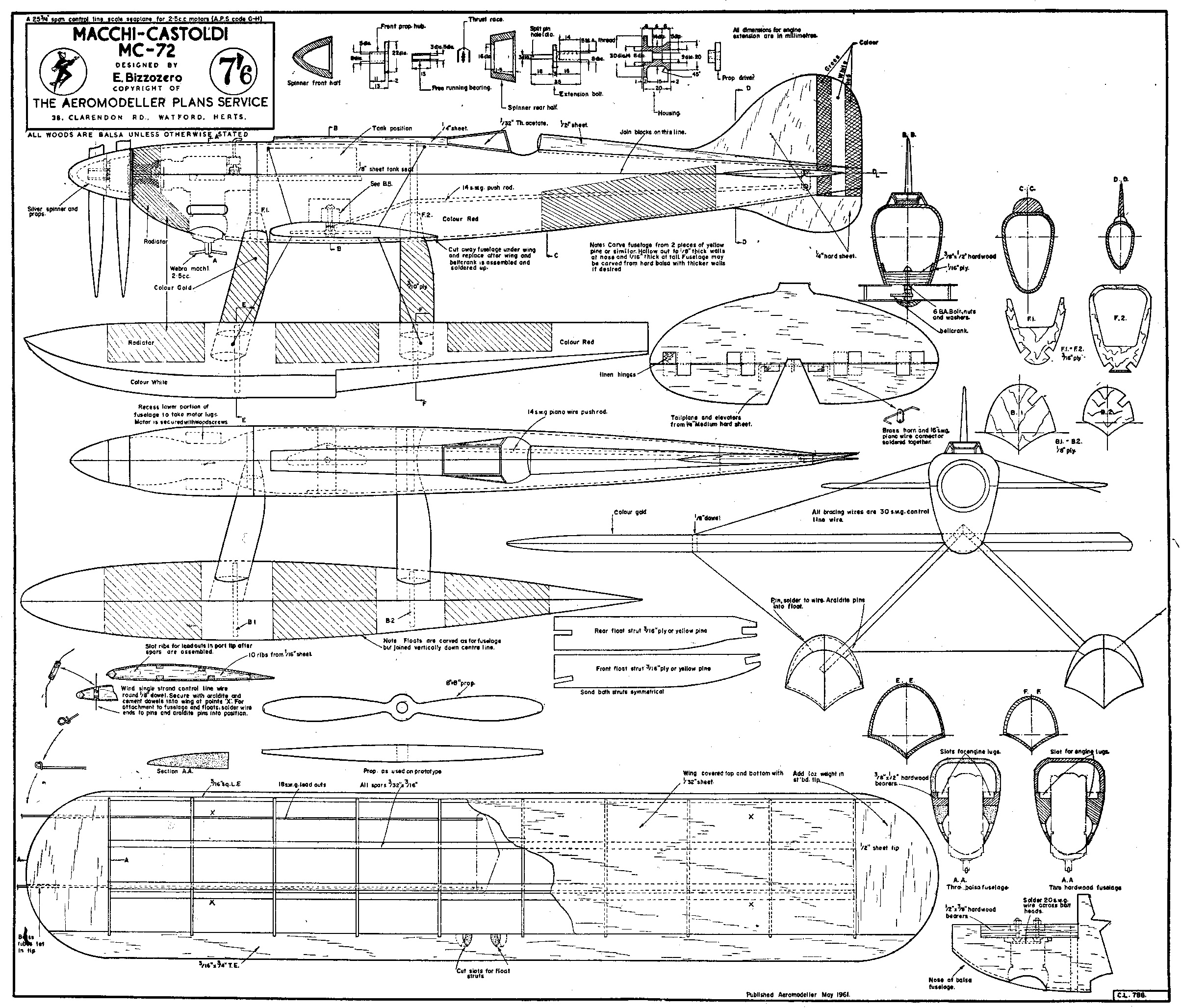The Plane
The MC-72 was designed for the Schneider Trophy but never competed. Although built in 1931, the plane still holds the world's speed record for a piston powered seaplane. You can learn more about the plane here and the pilot, Francesco Agello.

The Model and Plans
There are a couple of reasonable sets of plans for the MC-72. I chose the plans by Ettore Bizzozero which are available at Aerofred. The plans were originally published in Aeromodeller in May, 1961 along with an article on the build. The plans were for a control line model. You could order the plans from Aeromodeller for "seven and six" which is about $20 today. The model is a little unusual in that the fuselage is carved from two blocks of balsa lightly glued together. Once you have carved the outer surface of the fuse, you separate the blocks and hollow out the cavity. I like the fact that for this model, he put a second propeller on an idler bearing so that the plane could look as close to the original as possible. You can see the position of the bell-crank where the control wires move the elevator.

Ettore Bizzozero
I don't normally pay a lot of attention to the authors listed on plans that are available online but given the theme of the competition and the fact that I wasn't just building a version of a plane, but using plans designed by someone else, I did a little research on Ettore Bizzozero. Unfortunately, the first thing that I learned was that he died in 2013 as recorded in a post from an Italian RC forum site. He was born in 1928 based on the fact that this picture was taken in 1942 when he was 14. He was clearly passionate about his hobby especially about modelling Schneider Cup planes. Many of the references I found were linked to his organizing of an annual Schneider Cup re-enactment on lakes close to Varese, which I think was his home town. He was president of the Varese aeromodellers club from 1951 to 1986.

There is a video of the Schneider Cup reenactment from 1967 and I'd like to think that the MC-72 at 1:30 in the video is his (it has the two props installed).
The MC-72 was designed for the Schneider Trophy but never competed. Although built in 1931, the plane still holds the world's speed record for a piston powered seaplane. You can learn more about the plane here and the pilot, Francesco Agello.

The Model and Plans
There are a couple of reasonable sets of plans for the MC-72. I chose the plans by Ettore Bizzozero which are available at Aerofred. The plans were originally published in Aeromodeller in May, 1961 along with an article on the build. The plans were for a control line model. You could order the plans from Aeromodeller for "seven and six" which is about $20 today. The model is a little unusual in that the fuselage is carved from two blocks of balsa lightly glued together. Once you have carved the outer surface of the fuse, you separate the blocks and hollow out the cavity. I like the fact that for this model, he put a second propeller on an idler bearing so that the plane could look as close to the original as possible. You can see the position of the bell-crank where the control wires move the elevator.

Ettore Bizzozero
I don't normally pay a lot of attention to the authors listed on plans that are available online but given the theme of the competition and the fact that I wasn't just building a version of a plane, but using plans designed by someone else, I did a little research on Ettore Bizzozero. Unfortunately, the first thing that I learned was that he died in 2013 as recorded in a post from an Italian RC forum site. He was born in 1928 based on the fact that this picture was taken in 1942 when he was 14. He was clearly passionate about his hobby especially about modelling Schneider Cup planes. Many of the references I found were linked to his organizing of an annual Schneider Cup re-enactment on lakes close to Varese, which I think was his home town. He was president of the Varese aeromodellers club from 1951 to 1986.

There is a video of the Schneider Cup reenactment from 1967 and I'd like to think that the MC-72 at 1:30 in the video is his (it has the two props installed).
Last edited:
